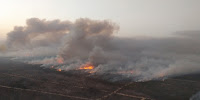The most limited rise in global temperatures, never mind higher ones, is going to exact a price through fire and drought. Even assuming the world keeps to its Paris promise to contain average planetary temperature increases to “well below 2°C” by 2100, drought conditions in China will intensify ten or 20-fold, according to new research.
And even if this warming, driven by ever increasing emissions of greenhouse gases from burning coal, oil and gas, is held to the implicit ambition of no more than 1.5°C above the average for most of human history, the area charred by wildfires each summer in Europe could increase by 40%, according to a separate study.
If the temperatures continue to rise to as much as 3°C by the century’s end, the area covered by charred foliage and smoking tree trunks could rise by 100%.
The temperature targets are important because 195 nations agreed in 2015 at a UN conference in Paris to limit greenhouse gas emissions and hold planetary average temperatures to if possible 1.5°C and certainly no more than 2°C.
3°C in prospect
In the last century or so, increasing ratios of carbon dioxide in the planet’s atmosphere have lifted average temperatures by about 1°C already, and although almost all nations have announced plans to switch to solar and wind power for future energy sources, and to restore the forests that absorb carbon, the world still seems on course for a rise to 3°C by the end of the century.
Politicians and climate skeptics argue that action to contain global warming will be expensive. But over and over again, climate science research continues to demonstrate that inaction could be even more expensive.
China is now the world’s largest emitter of greenhouse gases. Scientists from China, Poland and Germany report in the Proceedings of the National Academy of Sciences that they used computer simulations and a range of climate change forecasts to model what could happen to rainfall and vegetation in China over the next 80 years, and then tried to calculate the effect on China’s developing economy.
Between 1949 and 2017, drought affected crops over an area of more than 2 million square kilometers – this is one sixth of the country’s arable land. And between 1984 and 2017, direct economic losses reached more than $7bn a year, at 2015 prices.
“Limiting global warming to 1.5°C can strongly reduce the increase of burned area”
If the temperature stabilizes at a 1.5°C increase, losses compared to the period 1986-2005 will increase tenfold. Compared to the immediate past of 2006-2015, the study estimates that losses will still rise threefold. And should the temperature go beyond 1.5°C to 2°C, average drought loss could double again.
Read more at Fire and Drought Threaten China and Europe

No comments:
Post a Comment